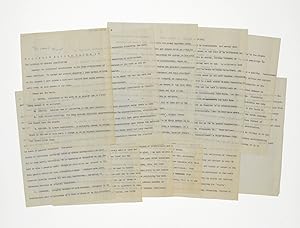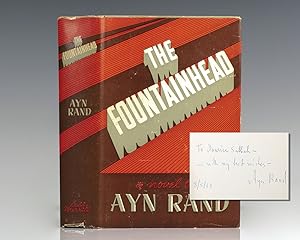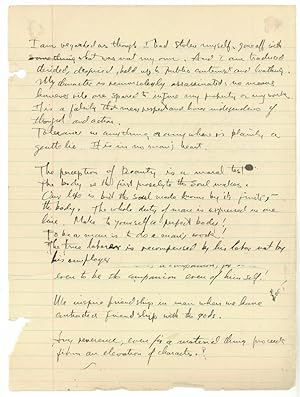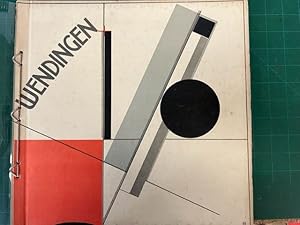frank lloyd wright (Más de 21.000 resultados)
ComentariosFiltros de búsqueda
Tipo de artículo
- Todos los tipos de productos
- Libros (20.360)
- Revistas y publicaciones (136)
- Cómics (1)
- Partituras (No hay ningún otro resultado que coincida con este filtro.)
- Arte, grabados y pósters (225)
- Fotografías (5)
- Mapas (1)
- Manuscritos y coleccionismo de papel (654)
Condición Más información
Encuadernación
Más atributos
Idioma (14)
Gastos de envío gratis
Ubicación del vendedor
Valoración de los vendedores
-
The Fountainhead.
Publicado por Bobbs-Merrill Company, Indianapolis, 1943
Librería: Raptis Rare Books, Palm Beach, FL, Estados Unidos de America
Original o primera edición Ejemplar firmado
EUR 177.831,80
Convertir monedaEUR 47,48 gastos de envío desde Estados Unidos de America a EspañaCantidad disponible: 1 disponibles
Añadir al carritoFirst edition, first issue with first edition stated on the copyright page of the author's first major novel, as well as her first best-seller. Octavo, original red cloth. Association copy, inscribed by the author on the front free endpaper, "To Jack L. Warner - Thank you for your courage and for a magnificent picture - with my profound gratitude - Ayn Rand. January 7, 1949." The recipient, Jack Warner, was the co-founder, president, and driving force behind the Warner Bros. Studios. His career spanned some 45 years, its duration surpassing that of any other of the seminal Hollywood studio moguls. Rand sold the film rights to Warner several years earlier with the contractual proviso that she would provide the screenplay, which would be unalterable. In fact, the director wanted changes, but Warner supported the author and honored the contract. This book's inscription, clearly referring to this, was presented about a half year prior to the film's release. Of Rand's fiction, The Fountainhead is generally conceded to be her most important and enduring work, a passionate portrait of uncompromising individualism. In the decades since its debut, the film has gained the critical acceptance, even the acclaim, that initially evaded it. Near fine in a near fine first-issue dust jacket with a touch of rubbing and no fading to the spine, which is endemic to this title. Housed in a custom full morocco clamshell box by The Harcourt Bindery. One of the finest association copies possible, linking the famed author with the legendary founder of Warner Brothers and producer of the iconic film. Although Rand was a previously published novelist and had a successful Broadway play, she faced difficulty in finding a publisher she thought right for The Fountainhead. She let Macmillian Publishing go when they rejected her demand for better publicity (Branden, 1986), and when her agent criticized the novel, she fired him and handled submissions herself (Burns, 2009). After sifting through eleven more publishers, Rand finally released The Fountainhead with Bobbs-Merrill Company in 1943. The reception was instant, and The Fountainhead became a bestseller in two years. The protagonist, Howard Roark, whose character was thought to be inspired by Frank Lloyd Wright, is a young architect fighting against convention. Cited by numerous architects as an inspiration, Ayn Rand said the theme of the book was "individualism versus collectivism, not within politics but within a man's soul." Rand chose architecture as the analogy of her heady themes because of the context of the ascent of modern architecture. It provided an appropriate mode to make relevant her beliefs that the individual is of supreme value, the "fountainhead" of creativity, and that selfishness, properly understood as ethical egoism, is a virtue. Some critics consider The Fountainhead to be Rand's best novel (Merill, 1991). Indeed, philosopher Mark Kingwell described it as "Rand's best work" (Kingwell, 2006). In 1949 it was adapted to film, produced by Henry Blanke, directed by King Vidor, starring Gary Cooper, Patricia Neal, Raymond Massey, Robert Douglas, and Kent Smith.
-
The Building Blocks of Albert Einstein's Creative Mind
Publicado por Germany, 1880
Librería: Seth Kaller Inc., White Plains, NY, Estados Unidos de America
EUR 160.048,62
Convertir monedaEUR 9,93 gastos de envío desde Estados Unidos de America a EspañaCantidad disponible: 1 disponibles
Añadir al carritoNo binding. Condición: Fine. Ephemera. Set of Anker-Steinbaukasten childrens building blocks by F. Ad. Richter & Cie., Rudolstadt, [Germany], c.1880s. Approximately 160 composite quartz sand, chalk, and linseed oil blocks in red, limestone and slate gray, in various sizes and shapes, together with three or more sets of building plans, all contained in two wooden boxes with printed Anker-Steinbaukasten labels. A unique and important artifact of his childhood. Einstein spent his childhood building "complicated structures" with these Anker-Steinbaukasten blocks. Accepting his later theory that "Imagination is more important than knowledge," the toys that encouraged his imagination became building blocks for the most important scientific theories of the last millennium.His sister Maja Winteler-Einstein, describing his childhood, recalled that "The games he played . were very characteristic of Albert's capacities. These were mostly puzzles, fretsaw work, the erection of complicated structures with the well-known Anker building blocks, and above all the construction of multi-storied card castles, with which he filled his leisure." ("Beitrag fr sein Lebensbild" in The collected papers of Albert Einstein. ed. John Stachel. Volume 1: The early years. 1879-1902. (Princeton University Press, 1987) p.lix. Translated from German.)Based on the work of German educator Friedrich Froebel (who created the concept of kindergarten) these composite stone blocks were a popular toy of the 1880s and 1890s. The blocks were designed to help develop childrens' tactile senses and manual dexterity, and also to stimulate imagination, creativity and three-dimensional perception. Fellow scientist J. Robert Oppenheimer, as well as architects Frank Lloyd Wright and Walter Gropius are among the geniuses who are known to have played with Anker blocks. ProvenanceThe set had passed by direct descent from Albert Einstein to the consignor from whom we acquired the blocks at Christie's London on July 13, 2016. ConditionA few blocks chipped and worn, with original instructions and boxes worn, soiled and defective.Albert Einstein (1879-1955) was a German-Swiss born theoretical physicist internationally recognized as one of the greatest physicists of all time. He enunciated the general theory of Relativity, with law explaining the relationship between the speed of light and its consequence, the equivalence of mass and energy (E=MC2). For his work in theoretical physics-largely for his 1905 paper on photons and photo-electricity-Einstein was awarded the Nobel Prize for Physics (announced in November 1922, retroactive for 1921). Working on a unified field theory, he then attempted to explain gravitation and electromagnetism within one set of laws. With the expulsion of Jewish scholars from Germany after Hitler's rise to power, Einstein joined the Institute for Advanced Study in Princeton, New Jersey (1933), which became the most celebrated research center in the world. In 1939, he signed a letter written to President Franklin Roosevelt warning him of the possibility of Germany developing a nuclear bomb. He urged the U.S. to begin uranium research, thus beginning the top secret "Manhattan Project." Later, at Princeton, he tried to develop a unified field theory and to refute the accepted interpretation of quantum physics, both unsuccessfully. Einstein received U.S. citizenship in 1940. Ephemera.
-
Ausgeführte Bauten und Entwürfe von Frank Lloyd Wright. (Studies and Executed Buildings by Frank Lloyd Wright). First edition. Complete with 100 plates.
Publicado por Berlin: Wasmuth, 1910
Librería: Wittenborn Art Books, San Francisco, CA, Estados Unidos de America
Arte / Grabado / Póster
EUR 75.578,51
Convertir monedaEUR 15,54 gastos de envío desde Estados Unidos de America a EspañaCantidad disponible: 1 disponibles
Añadir al carritoCondición: Good. Folio. 40.5 x 64 cm; 16 x 25 inches sheet sizes.2 vols., text vol.: 30pp. unbound as issued. Folio: 72 lithograph plates on thick wove paper (1 printed in gold) and 28 plates on translucent paper (with a total of 100 different plates), each with the blindstamp of Frank Lloyd Wright. The leaves loosely inserted in 2 original printed board portfolios with cloth ties.Plates are very good to fine since this set was sold by Wasmuth and never made it to Taliesin, where most were water damaged or destroyed. Provenance: From the Collection of the important Dutch architect Jan Wils,who was a member of the modernist De Stijl movement. His bookplates on the inside covers of the 2 portfolios. Wils became an admirer and great advocate in the Netherlands of Wright's work and wrote about the master.See: Jan Wils, Frank Lloyd Wright e De Stijl by Ezio Godoli. Calenzano : Modulo, 1980. In 1916, Wils established his own architectural firm in The Hague.The Papaverhof is a housing complex in The Hague that was designed by Jan Wils. Built between 1919 and 1921, the project was Wils' breakthrough as an architect. Today the Papaverhof is a Rijksmonument that is one of the Top 100 Dutch heritage sites. Frank Lloyd Wright's Lexington Terraces (1894) project in Chicago, Illinois was the inspiration for the Papaverhop design.Wils was one of the founding members of the De Stijl movement, which also included artists as Piet Mondrian, Theo van Doesburg and Gerrit Rietveld.Among other works, Wils designed the Olympic Stadium for the 1928 Summer Olympics in Amsterdam. His design was also entered in the Olympic art competition, and won the gold medal. Following is a list of the plates: VOLUME I: 1: Plates 1-33)1) Tafel I (1T) Tissue Winslow Detail;2) Tafel I (1) Plate Winslow Perspective;3) Tafel II (2)Plate Devin Perspective and Floor Plan;4) Tafel III (3)Plate Winslow Stable Perspective and Floor Plan;5) Tafel IV (4)Plate Heller, Detail; Husser Perspective, Floor Plan, Detail;6) Tafel V (5)Plate Francis Apartments Perspective and Floor Plan;7) Tafel VI (6)Plate Frank Lloyd Wright, Oak Park Perspective and Floor Plan;8) Tafel VII (7T) Tissue Lexington Terrace Floor Plan;9) Tafel VII (7)Plate Lexington Terrace Perspective;10) Tafel VIII (8T) Tissue Mcafee Floor Plan;11) Tafel VIII (8)Plate Mcafee Perspective;12) Tafel IX (9T) Tissue Metzger Perspective and Floor Plan;13) Tafel IX (9) Plate Metzger Perspective;14) Tafel X (10T) Tissue Hillside Home School Floor Plan;15) Tafel X (10)Plate Hillside Home School Perspective;16) Tafel XI (11)Plate River Forest Golf Club Perspective and Floor Plan;17) Tafel XII (12T) Tissue Study for Concrete Bank Cut-Away Perspective;18) Tafel XII (12)Plate Study for Concrete Bank Perspective and Floor Plan;19) Tafel XIII (13)Plate Quadruple Block Plan House Perspective;20) Tafel XIIIa (13a)Plate Quadruple Block Plan Perspective and Floor Plan;21) Tafel XIV (14) Plate Concrete House For LHJ Perspective;22) Tafel XIVa (14a)Plate Concrete House For LHJ Perspective and Floor Plan;23) Tafel XV (15T) Tissue Hardy Floor Plan;24) Tafel XV (15T) Tissue Hardy Perspective;25) Tafel XV (15)Plate Hardy Perspective;26) Tafel XVI (16T) Tissue Ullman Floor Plan;27) Tafel XVI (16)Plate Ullman Perspectives (2);28) Tafel XVII (17T) Tissue Heath Floor Plan;29) Tafel XVII (17)Plate Heath Perspective;30) Tafel XVIII (18)Plate Thomas Perspective and Floor Plan;31) Tafel XIX (19)Plate Martin Perspective and Floor Plan;32) Tafel XX (20)Plate Heurtley Perspective and Floor Plan;33) Tafel XXI (21)Plate Martin Perspective and Floor Plan;34) Tafel XXII (22)Plate Bradley Living Room Perspective and Detail;35) Tafel XXIII (23)Plate Curtis Publishing Company Perspective and Floor Plan;36) Tafel XXIV (24)Plate Hickox Perspective and Floor Plan;37) Tafel XXV (25) Plate Willits Perspective and Floor Plan;38) Tafel XXVI (26)Plate Martin Perspective and Floor Plan;39) Tafel XXVII (27)Plate Henderson Perspective and Floor Plan;40) Tafel XXVIII (28)Plate Little Perspective and Floor Plan;41) Tafel XXIX (29)Plate De Rhodes Perspective, Floor Plan & Detail;42) Tafel XXX (30T) Tissue Cheney Floor Plan;43) Tafel XXX (30)Plate Cheney Perspective;44) Tafel XXXI (31T) Tissue Dana Floor Plan;45) Tafel XXXI (31)Plate Dana Perspective;46) Tafel XXXIa (31a) Plate Dana Perspective;47) Tafel XXXIb (31b)Plate Dana Interior and Detail;48) Tafel XXXII (32T) Tissue Martin Floor Plan;49) Tafel XXXII (32)Plate Martin Perspective;50) Tafel XXXIII (33T) Tissue Larkin Perspective Interior;51) Tafel XXXIII (33)Plate Larkin Perspective and Floor Plan;52) Tafel XXXIIIa (33a)Plate Larkin Perspective and Floor Plan;(VOLUME II: Plates 34-64)53) Tafel XXXIV (34T) Tissue Shaw Floor Plan);54) Tafel XXXIV (34)Plate Shaw Perspective;55) Tafel XXXV (35)Plate Tomak Perspective and Floor Plan;56) Tafel XXXVI (36)Plate Larkin & Browne's Perspectives and Floor Plan;57) Tafel XXXVII (37T) Tissue Robie Floor Plan58) Tafel XXXVII (37)Plate Robie Perspective;59) Tafel XXXVIII (38T) Tissue Horse Shoe Inn Floor Plan;60) Tafel XXXVIII (38)Plate Horse Shoe Inn Perspective;61) Tafel XXXIX (39)Plate Clark Perspective and Floor Plan;62) Tafel XL (40)Plate Waller/Fuller Perspectives and Floor Plan;63) Tafel XLI (41)Plate Pettit Perspectives and Floor Plan;64) Tafel XLII (42) Plate River Forest Tennis Club Perspective and Floor Plan;65) Tafel XLIII (43)Plate Glasner Perspective and Floor Plan;66) Tafel XLIIIa (43a)Plate Summer Perspectives (2);67) Tafel XLIV (44)Plate Millard Perspective and Floor Plan;68) Tafel XLV (45)Plate Gale Perspective and Floor Plan;69) Tafel XLVI (46T) Tissue Como Orchards Plot Plan;70) Tafel XLVI (46)Plate Como Orchards Areal Perspective;71) Tafel XLVII (47)Plate Como Orchards Club House Perspective;72) Tafel XLVIIa (47a) Plate Como Orchards Cottages (3) Perspectives;73) Tafel XLVIII (48T) Tissue Waller Houses (3) Floor Plans;74) Tafel XLVIII (48)Plate Waller Houses (3) Perspectives;75) Tafel IL (49T) Tissue City National Bank Perspective and Floor Plan.
-
The Fountainhead.
Publicado por Bobbs-Merrill Company, Indianapolis, 1943
Librería: Raptis Rare Books, Palm Beach, FL, Estados Unidos de America
Original o primera edición Ejemplar firmado
EUR 66.686,92
Convertir monedaEUR 47,48 gastos de envío desde Estados Unidos de America a EspañaCantidad disponible: 1 disponibles
Añadir al carritoFirst edition, first issue with first edition stated on the copyright page of the author's first major novel, as well as her first best-seller. Octavo, original red cloth. Association copy, inscribed by the author in the year of publication on the front free endpaper, "To Gertrude Lynneberg- - with my best wishes for long years of happiness- Ayn Rand November 16, 1943." The recipient, Gertrude Lynneberg was the sister-in- law to Linda Lynneberg, also known as Aslaug Lynneberg, a lifelong friend of Rand. Near fine in a very good first issue dust jacket with some chips and wear. Housed in a custom half morocco clamshell box made by the Harcourt Bindery. First editions in the original dust jacket are uncommon, association copies rare. Although Rand was a previously published novelist and had a successful Broadway play, she faced difficulty in finding a publisher she thought right for The Fountainhead. She let Macmillian Publishing go when they rejected her demand for better publicity (Branden, 1986), and when her agent criticized the novel, she fired him and handled submissions herself (Burns, 2009). After sifting through eleven more publishers, Rand finally released The Fountainhead with Bobbs-Merrill Company in 1943. The reception was instant, and The Fountainhead became a bestseller in two years. The protagonist, Howard Roark, whose character was thought to be inspired by Frank Lloyd Wright, is a young architect fighting against convention. Cited by numerous architects as an inspiration, Ayn Rand said the theme of the book was "individualism versus collectivism, not within politics but within a man's soul." Rand chose architecture as the analogy of her heady themes because of the context of the ascent of modern architecture. It provided an appropriate mode to make relevant her beliefs that the individual is of supreme value, the "fountainhead" of creativity, and that selfishness, properly understood as ethical egoism, is a virtue. Some critics consider The Fountainhead to be Rand's best novel (Merill, 1991). Indeed, philosopher Mark Kingwell described it as "Rand's best work" (Kingwell, 2006). In 1949 it was adapted to film, produced by Henry Blanke, directed by King Vidor, starring Gary Cooper, Patricia Neal, Raymond Massey, Robert Douglas, and Kent Smith.
-
Ausgeführte Bauten und Entwürfe von Frank Lloyd Wright.
Publicado por Berlin, Ernst Wasmuth, [1910]., 1910
Librería: Antiquariat INLIBRIS Gilhofer Nfg. GmbH, Vienna, A, Austria
Original o primera edición
EUR 65.000,00
Convertir monedaEUR 20,00 gastos de envío desde Austria a EspañaCantidad disponible: 1 disponibles
Añadir al carrito1 text volume and 2 portfolios with lithographed plates. Oblong folio (plates and their portfolio, ca. 64 x 40 cm) and folio (text volume, ca. 41 x 32 cm). Text volume: 30, [1], [1 blank] pp.; plus 100 lithographed plates. Text volume with the title printed in gold. With a total of 100 lithographed plates over 2 portfolios: 72 plates numbered I-LXIV, printed on gray or white paper and mostly printed in brown, some in gray, gray & white or brown & white, one in gold (plate I), one in colour (plate LXIV) and one plate is folding (plate LX), and 28 overlays, printed in brown on tissue paper. Each plate is embossed with Wright's blindstamp. Kept loose, as issued, in the original two portfolios (64 x 41.5 cm), both dark blue half cloth with the original publisher's printed grey wrappers over boards with all white ties present. Both portfolios and text leaves are kept in a larger, later beige half cloth portfolio (ca. 65 x 43 cm) with brown paper sides, three protective flaps and white ties. Extremely rare first edition, of the complete collection of plates prepared from drawings made by master architect Frank Lloyd Wright (1867-1959) at his Oak Park Studio, illustrating seventy buildings and projects completed between 1893 and 1909. It is the first major publication by one of the true innovators of modern architecture. The work boosted Wright's fame in European architectural circles and influenced key figures in contemporary architecture such as Ludwig Mies van der Rohe, Peter Behrens and Le Corbusier. The plates show perspective views, plans, sections and interior and exterior details. Plate LVI, with an interior view of the living room of the Coonley House, is one of the most important and desirable of the series. Other works represented are the Frederic Robie House, Susan Lawrence Dana House, Ward Willets House, Darwin Martin House, Avery Coonley House, the Larkin Building, and Unity Temple, showing the variety of his buildings. - Although each plate is embossed with Wright's blindstamp, Sweeney notes that he completed the work alongside assistants and collaborators, including Marion Mahony Griffin and Wright's son, Lloyd. A massive undertaking, the work was printed by Ernest Wasmuth. The original plans and presentation drawings had to be lithographed on large stones. The text volume, written by Wright, was printed both in German and in English, containing an essay on his architectural style and a list of the plates. The text part starts with the introduction by Wright, translated into German by Wasmuth, and is dated ''Florenz, Italien, 15. Mai 1910'', followed by an annotated list of plates (pp. 21-30). An English version of the introduction was printed in Chicago by Ralph Fletcher Seymour, dated "Florence, Italy, June 1910". - The edition is scarce due to the fire at Wright's home and studio, Taliesin, in August 1914. The fire destroyed the bulk of the American copies of this portfolio, in addition to much of Wright's other work. Many of the copies intended for the American market were destroyed, for which reason the work was far better known in Europe than in the United States. - Large half beige portfolio worn: a little stained, edges a little worn, head and outer protective flap half loose, bottom protective flap loose but present, linen ties somewhat frayed. Two ties of the second plate portfolio are torn and frayed. Text volume: some plates and the wrappers of both portfolios somewhat foxed, some plates with some occasional marginal tears (never affecting them), overlays a little toned. Overall a complete set with the plates, booklet and the two original publisher's portfolios still in good condition, being Wright's extremely rare magnum opus which secures his status in Europe and being one of the most influential architectural publications of the century. - Kruft 210. Robert L. Sweeney, Frank Lloyd Wright: An Annotated Bibliography, Los Angeles, 1978, 87. Thieme-Becker XXXVI, 279.
-
Ausgeführte Bauten und Entwürfe von Frank Lloyd Wright.
Publicado por Ernst Wasmuth,, Berlin,, 1910
Librería: Antiquariaat FORUM BV, Houten, Holanda
Original o primera edición
EUR 65.000,00
Convertir monedaEUR 14,50 gastos de envío desde Holanda a EspañaCantidad disponible: 1 disponibles
Añadir al carrito1 text volume and 2 portfolios with lithographed plates. Extremely rare first edition, of the complete collection of plates prepared from drawings made by master architect Frank Lloyd Wright (1867-1959) at his Oak Park Studio, illustrating seventy buildings and projects completed between 1893 and 1909. It is the first major publication by one of the greatest innovators of modern architecture. The work boosted Wright's fame in European architectural circles and influenced key figures in contemporary architecture including Ludwig Mies van der Rohe, Peter Behrens and Le Corbusier. The plates show perspective views, plans, sections and interior and exterior details. Plate LVI, with an interior view of the living room of the Coonley House, is one of the most important and desirable of the series. The edition is scarce due to a fire at Wright's home and studio, Taliesin, in August 1914. The later portfolio worn: a little stained, edges a little worn, head and outer protective flap half loose, bottom protective flap loose but present, linen ties somewhat frayed. Two ties of the second plates portfolio are torn and frayed. Text volume, some plates and the wrappers of both portfolios somewhat foxed, some plates with occasional marginal tears (never affecting the image), overlays a little toned. Overall a complete set with the plates, booklet and the two original publisher's portfolios still in good condition, being Wright's extremely rare magnum opus that secured his status in Europe: one of the most influential architectural publications of the century.l Kruft 210; Robert L. Sweeney, Frank Lloyd Wright: an annotated bibliography, 1978, 87; Thieme-Becker XXXVI, 279. Kept loose, as issued, in the original two portfolios (64 x 41.5 cm), both dark blue half cloth with the original publisher's printed grey wrappers over boards with all white ties present. Both portfolios and text leaves are kept in a larger, later beige half cloth portfolio (ca. 65 x 43 cm) with brown paper sides, three protective flaps and white ties. Text volume with the title printed in gold. With a total of 100 lithographed plates in 2 portfolios: 72 plates numbered I-LXIV, printed on grey or white paper and mostly printed in brown, some in grey, grey & white or brown & white, one in gold (plate I), one in colour (plate LXIV) and one plate folding (plate LX), and 28 overlays, printed in brown on tissue paper. Each plate embossed with Wright's blind stamp. Pages: 30, [1], [1 blank] pp.; plus 100 lithographed plates. 1mo (plates, ca. 64 x 40 cm) and folio (text volume, ca. 41 x 32 cm).
-
Ausgeführte Bauten und Entwürfe von Frank Lloyd Wright (Completed Building and Designs of Frank Lloyd Wright) [The Wasmuth Portfolio]
Publicado por Ernst Wasmuth, Berlin, 1910
Librería: Manhattan Rare Book Company, ABAA, ILAB, New York, NY, Estados Unidos de America
Original o primera edición
EUR 62.241,13
Convertir monedaEUR 43,16 gastos de envío desde Estados Unidos de America a EspañaCantidad disponible: 1 disponibles
Añadir al carritoOriginal boards. Condición: Very Good. First edition. RARE FIRST EDITION OF FRANK LLOYD WRIGHT'S MAGNIFICENT WASMUTH PORTFOLIO, COMPLETE WITH ALL 100 LARGE FOLIO PLATES. Known the world over as the Wasmuth portfolio, the immensely influential Ausgeführte Bauten und Entwürfe (1910) was a project conceived by Ernst Wasmuth-a Berlin publisher of high-end art books who "intended to publish a complete portfolio of Wright's work to that date [.] that would become a collector's item" (Secrest, Biography, p. 203). In contrast to the compact Frank Lloyd Wright: Ausgeführte Bauten, the Wasmuth portfolio is a grand expression of Wright's architectural vision, containing 100 lithographs of his most successful projects completed by 1910, including: Unity Temple, I.L.; the Robie House, I.L.; the Westcott House, O.H.; and the Cheney House, I.L. (the project on which he met his lover Mrs. Mamah Borthwick Cheney). The extraordinary portfolio showcased here presents an exceptional opportunity to own first-rate architectural drawings compiled by Wright himself and crafted in exquisite detail by Wasmuth. The Wasmuth portfolio is rare in any form, with many partial copies surviving today. Wasmuth produced only 650 copies, 500 of which were sent to Wright for circulation in the U.S. A fire on August 15, 1914, however, at Wright's home and studio, Taliesin, caused the destruction of over 400 of these copies, with Wright noting that only 30 damaged portfolios were salvaged. Thus, less than 200 copies are speculated to exist, fewer in fine or complete condition. Le Corbusier is one of the known owners of the portfolio, and its influence on twentieth-century European architects, namely Walter GropiusandLudwig Mies van der Rohe, was immediate. However, in addition to encapsulating Wright's burgeoning impact on the history of modern architecture, the portfolio captures a tender moment in Wright's life, sitting at the centre of his affair with Mrs. Cheney. The voyage to Germany to collaborate with Wasmuth offered Wright a glimpse at life with his newfound partner. Such joy, tragically, was short lived. The aforementioned Taliesin fire was in fact an act of arson, committed by one of the house's servants, that took the life of Mrs. Cheney, her two children as well as four others. Thus, any copy of the Wasmuth portfolio carries a deeply sentimental weight amidst a complex personal history. The portfolio includes 72 high-quality plates and 28 tissue overlays. Each plate and overlay is embossed in blind with "FRANK LLOYD WRIGHT" and a sigil of two squares one in another. The plates are printed on either a bright, eggshell-coloured paper or a darker paper that allows white highlights and darker shades to be added. Two plates (I: The Winslow Villa in River Forest, Illinois; and LXII: The Richard Bock Atelier in Oak Park, Illinois) are decadently lined in gold, adding a further dimension of depth to the drawings. Note: The text booklet is often lacking but is here present, though incomplete and in an unusual state, perhaps indicating a trial or unsold version. Containing an Introduction by Wright in German, but with pp. 1-4 as unfolded folio sheets, missing pages 5-16 (three sheets). The rest of the pamphlet folded in booklet form. With Index from pp. 21-30; Acknowledgement from Wright on p. 31; all in German. ALSO WITH (as an extra): Wright, Frank Lloyd. Ausgeführte Bauten. Berlin: Ernst Wasmuth, 1911. Often known as "Little Wasmuth" this small format edition was published after the large portfolio. With color frontispiece of Unity Temple and black and white illustrations throughout. Original stiff wrappers. Fragile front wrapper split and almost detached. Text in German. References: Anthony Alofsin, 'Wright, Frank Lloyd', in American National Biography, 24 vols (Oxford: Oxford University Press, 1999), XXIV, pp. 15-20. Meryle Secrest, Frank Lloyd Wright: A Biography (New York: Knopf, 1992). WRIGHT, FRANK LLOYD. Ausgeführte Bauten und Entwürfe von Frank Lloyd Wright. Large oversized folio (25 x 16 inches) sheets (72 plates with 28 tissue overlays), housed as issued in two cloth folding cases with original ties (all but one attached). Text and plates loose as issued. Some general light wear to portfolio cases. One of the overlays (LVIII) detached, one small tear in another. Plates remarkably clean and extremely rare as such, since a significant percentage of extent copies have missing or damaged plates. The list of all plates is available upon inquiry. ONE OF THE MOST IMPORTANT AND INFLUENTIAL ARCHITECTURAL PUBLICATIONS OF THE 20TH CENTURY. RARE.
-
Ausgeführte Bauten und Entwürfe von Frank Lloyd Wright.
Publicado por Ernst Wasmuth,, Berlin,, 1910
Librería: Antiquariaat FORUM BV, Houten, Holanda
Original o primera edición
EUR 49.500,00
Convertir monedaEUR 14,50 gastos de envío desde Holanda a EspañaCantidad disponible: 1 disponibles
Añadir al carrito1 text part and 2 portfolios with lithographed plates. Extremely rare first edition, of the complete collection of plates prepared from drawings made by master architect Frank Lloyd Wright (1867-1959) at his Oak Park Studio, illustrating seventy buildings and projects completed between 1893 and 1909. It is the first major publication by one of the greatest innovators of modern architecture. The work boosted Wright's fame in European architectural circles and influenced key figures in contemporary architecture including Ludwig Mies van der Rohe, Peter Behrens and Le Corbusier. The plates show perspective views, plans, sections and interior and exterior details. Plate LVI, with an interior view of the living room of the Coonley House, is one of the most important and desirable of the series. Other works represented are the Frederic Robie House, Susan Lawrence Dana House, Ward Willets House, Darwin Martin House, Avery Coonley House, the Larkin Building, and Unity Temple, showing the variety of his buildings.Although each plate is embossed with Wright's blind stamp, Sweeney notes that Wright completed the work alongside assistants and collaborators, including Marion Mahony Griffin and Wright's son, Lloyd. The work was printed by Ernest Wasmuth, a massive undertaking. The original plans and presentation drawings had to be lithographed on large stones. The text volume, written by Wright, was printed both in German and in English, containing an essay on his architectural style and a list of the plates. The text part starts with the introduction by Wright, translated into German by Wasmuth, and is dated ''Florenz, Italien, 15. Mai 1910'' and is followed by an annotated list of plates (pp. 21-30). An English version of the introduction was printed in Chicago by Ralph Fletcher Seymour being dated "Florence, Italy, June 1910".The edition is scarce due to a fire at Wright's home and studio, Taliesin, in August 1914. The fire destroyed the bulk of the American copies of this portfolio, in addition to much of Wright's other work. So many of the copies intended for the American market were destroyed, with the result that the work was far better known in Europe than in the United States.The wrappers and ties of the two portfolios are browned, both spines are worn (with the portfolios otherwise still intact) and the front board of portfolio II shows a seriously water damaged spot. All text leaves, plates and plates on overlay paper are foxed, the edges of the plates and overlays are show very slight water stains and are occasionally slightly frayed and browned, the overlays of plates LVIII and IL show a marginal tear, not affecting the image. The main surface of the plates (including the whole or the majority of the designs) are fine and clean. Overall a complete set with the plates, booklet and the two original publisher's portfolios still in good condition, being Wright's extremely rare magnum opus that secured his status in Europe: one of the most influential architectural publications of the century.l Kruft 210; Robert L. Sweeney, Frank Lloyd Wright: an annotated bibliography, 1978, 87; Thieme-Becker XXXVI, 279. Kept loose, as issued, in the original two portfolios (64 x 41.5 cm), both dark blue half cloth with the original publisher's printed grey wrappers over boards with all white ties present. The text leaves are kept in the first portfolio. Text volume with the title printed in gold. With a total of 100 lithographed plates in 2 portfolios: 72 plates numbered I-LXVI, prnited on grey or white paper and mostly printed in brown, some in grey, grey & white or brown & white, one in gold (plate I), one in colour (plate LXIV) and one plate folding (plate LX), and 28 overlays, printed in brown on tissue paper. Each plate embossed with Wright's blind stamp. Pages: 30, [1], [1 blank] pp.; pllus 100 lithographed plates. 1mo (plates, ca. 64 x 40 cm) and folio (text, ca. 41 x 32 cm).
-
The House Beautiful (Frank Lloyd Wright's Mother's Copy of His First Book)
Publicado por Auvergne Press, River Forest, Illinois, 1896
Librería: APPLEDORE BOOKS, ABAA, WACCABUC, NY, Estados Unidos de America
Original o primera edición Ejemplar firmado
EUR 31.120,56
Convertir monedaEUR 38,85 gastos de envío desde Estados Unidos de America a EspañaCantidad disponible: 1 disponibles
Añadir al carritoHalf Calf. Condición: Very Good. Frank Lloyd Wright Ilustrador. A deeply-personal Association copy of the 1896 1st edition of Frank Lloyd Wright's 1st published book, #37 OF ONLY 90 COPIES PRINTED. THIS COPY BELONGED TO FRANK LLOYD WRIGHT'S MOTHER, ANNA LLOYD WRIGHT, WHO SIGNED HER NAME ON THE FIRST BLANK ENDPAPER AND ALSO INCLUDED A PRINTED, LAID-IN CARD. Small folio, original half-polished calf with gilt-line borders and green paper-covered sides; top-edge gilt. 55 pages. SIGNED BY BOTH FRANK LLOYD WRIGHT AND W.H. WINSLOW (one of Wright's most important early clients) at the limitation. "Printed by hand at the Auvergne Press in River Forest by William Herman Winslow and Frank Lloyd Wright during the winter months of the year eighteen hundred ninety six and seven". Though Wright did not write the text, this really has to be considered his first book as the page decorations were entirely designed by him; in addition, the volume incorporates a booklet sewn to the front endpaper which contains a series of twelve hand-printed collotypes of dried weeds from photographs made by Wright. (Wright himself considered this his first book and said so in a letter to the Boston bookseller Samuel R. Morrill, "The Turn of a Century", #141). It is a famous book, both in the history of Frank Lloyd Wright and as an outstanding American press book. This copy descended in the family of Maginel Wright Barney, Frank Lloyd Wright's youngest sister. Edges of covers are somewhat worn; corners have been restored. Rebacked in matching polished calf. Very light old water stain in lower gutter splaying out to lower blank margins of both rectos and versos; hardly noticeable. Preserved in a handsome, dark-green, custom-made clamshell box.
-
Der Kuss (The kiss), collotype print from the portfolio Das Werk
Publicado por H.O. Miethke, [Wein, 1914
Librería: Rulon-Miller Books (ABAA / ILAB), St. Paul, MN, Estados Unidos de America
EUR 21.673,25
Convertir monedaEUR 56,11 gastos de envío desde Estados Unidos de America a EspañaCantidad disponible: 1 disponibles
Añadir al carritoFramed collotype print, image measuring 12" x 12", sheet measuring 18½" x 17¾", frame measuring 22½" x 22¼"; very light 2-in. curl at bottom margin, not affecting print, a touch of wear to top edge, otherwise fine. Not inspected out of frame. Taken from Klimt's portfolio Das Werk, limited to 300 copies, the only collection of Klimt's work produced in his lifetime and with his direct participation, and with his gold signet designed by him in the bottom margin. "Der Kuss" is one of Klimt's most famous and iconic works, and is one of only ten in the portfolio produced in color. Among the original subscribers were Frank Lloyd Wright and the Emperor Franz Josef. Full portfolios have sold at auction for as high as 70,000 euros.
-
The House Beautiful
Publicado por Auvergne Press, River Forrest, Illinois, 1896
Librería: Revaluation Books, Exeter, Reino Unido
Original o primera edición
EUR 17.735,92
Convertir monedaEUR 11,48 gastos de envío desde Reino Unido a EspañaCantidad disponible: 1 disponibles
Añadir al carritoQuarter Calf. Condición: Very Good. No Jacket. First Edition. Printed on hand-made paper with deckle edges. Double-page title in red and black, text printed within engraved frames, some full-page engraved illustrations, some ornaments printed in red, 12 photogravures of plants printed on Japan paper, bound as a booklet into green card wrappers with gold printing, and pasted on the front free endpaper as issued. (Some spotting to yapp edges, Japan paper spotted.) Original quarter calf and green paper covers, gilt frames on calf sides, the upper side also titled in gilt (dampstained, extremities rubbed, some soiling, some abrasion on upper cover). FIRST EDITION, DESIGNED AND PRINTED BY FRANK LLOYD WRIGHT. One of only 90 copies, this one number 78, signed by Wright and Winslow. The design of The House Beautiful established the form followed by most of Wright's subsequent books, and prefigures some of his famous stained-glass window designs. Auvergne Place, the house where this work was printed, was designed by Wright for Winslow and built in 1893; it had been Wright's first independent commission after leaving Adler and Sullivan. The photogravures reproduce dried weeds and plants which inspired Wright's illustrations.
-
original architectural plans for his last Usonian House with a TASCHEN book
Año de publicación: 1957
Librería: First and Fine, Ludlow, Reino Unido
Original o primera edición Ejemplar firmado
EUR 16.553,52
Convertir monedaEUR 28,70 gastos de envío desde Reino Unido a EspañaCantidad disponible: 1 disponibles
Añadir al carritoHardcover. Condición: Near Fine. 1st Edition. Frank Lloyd Wright (1867-1959) Architectural Plans for His Last Usonian House, 1957. In addition, a TASCHEN (2018) coffee table book by Bruce Brooks Pfeiffer and Peter Goessel about Frank Lloyd Wright's architectural masterpieces, published in three languages (English, German and French). The floor plans come with the necessary paperwork which ascertain provenance and authenticity. Drawing/Rendering of the Duey Wright House, Wausau, Wisconsin, circa 1957. Ink, graphite and coloured pencil on paper, 44.5″ x 29.5″ A superb and impressive drawing of three views of the house with the elevation scales. Slight creasing, mostly to the corners, with small edge tear. Signed by the master himself "FLW July 57" Perched on a bluff top overlooking the Wisconsin River, the Duey Wright House is one of Frank Lloyd Wright's last Usonian residences. Built for Duey and Julia Wright (not related to the architect) who owned a local music store and music school, the home's unusual L-shaped footprint has been suggested to represent a quarter note in honor of the musical couple. Moreover, a repeated geometric design found throughout the home in perforated plywood panels suggests musical notation. Wright used these panels in the exterior windows and as screens between rooms. The unadorned concrete block walls combine with the wide overhanging eaves to create a low horizontal look to the home. The longest wing, which runs east to west, is principally used for bedrooms, with the carport on the east end and the library on the west end. The two wings are joined on the west end by a large concrete block chimney, which allows for a library fireplace, and another in the living room. The circular living room contains a continuous band of windows allowing for a panoramic view of the Wisconsin River to the southwest, and Rib Mountain in the distance. The Usonian House conceptualised by architect Frank Lloyd Wright is the embodiment of an idea for a simple, stylish small house of moderate cost designed especially for the American middle class. It is not so much a style as a type of residential architecture. "Style is important," wrote Wright. "A style is not." When looking at a portfolio of Wright's architecture the casual observer might not even pause at Wrights first Usonian house from 1937, looking so familiar and ordinary yet, Usonian architecture was another obsession of the famous Frank Lloyd Wright in the last decades of his long life. By the 1950s, he had designed dozens of what he was then calling his Usonian Automatics. Wright didn't want to be known solely as an architect of the rich and famous, although his early residential experimentation in Prairie house design had been subsidized by families of means. The competitive Wright quickly became interested in affordable housing for the masses. In 1936, when the United States was in the depths of the Great Depression, Wright realized that the nation's housing needs would forever be changed. Most of his clients would lead more simple lives, without household help, but still deserving of sensible, classic design. "It is not only necessary to get rid of all unnecessary complications in construction" wrote Wright, "it is necessary to consolidate and simplify the three appurtenance systems heating, lighting, and sanitation." Designed to control costs, Wright's Usonian houses had no attics, no basements, simple roofs, radiant heating (what Wright called "gravity heat"), natural ornamentation, and efficient use of space, inside and out. Some have said that the word Usonia is an abbreviation for United States of North America. This meaning explains Wright's aspiration to createa democratic, distinctly national style that was affordable for the"common people" of the United States. A superb, impressive architectural drawing of this important house with the elevation scales. First and Fine. Signed by Author(s).
-
Wendingen. Maandblad voor bouwen en sieren van "Architectura et Amicitia." Edited by H.Th. Wijdeveld. Volume 1 - 12. [COMPLETE SET OF 116 VOLUMES].
Librería: Antiquariaat A. Kok & Zn. B.V., Amsterdam, Holanda
EUR 16.500,00
Convertir monedaEUR 15,95 gastos de envío desde Holanda a EspañaCantidad disponible: 1 disponibles
Añadir al carritoAmsterdam, De Hooge Brug/ Santpoort, C.A. Mees, 1918-1931. 116 parts in 143 volumes. Num. ills. All issues bound as blockbook, each number bound with raffia, orig. stiff col. lithogr./ woodcut wrappers. 7 part in orig. boards. Square 4to. - Most vols. contents (very) fine; a few vols. (sl.) yellowed/ trifle foxed. Wrs. varying from (sl.) frayed to good/ very good and occas. very fine; only a few w. broken ties. Year 2, no.7/8 (Houtsnedennummer) INCLUDING the folded woodcut by C.A. Lion Cachet, edges of wr. frayed; year 4, no.11 (Wright, cover: El Lissitzky): with some sm. stains on frontcover and w. bookplate on title-page.Rare complete run of this legendary periodical, with a few rare inserts, partly loosely inserted in the corresponding issues (i.e. 14 'Technical Sections', 1 purple inlay sheet and 2 'Announcements'). Includes 7 copies in deluxe ed. (year 1 no. 1, year 3 no 11/12, year 4 nos. 3 and 6, year 6 no. 2, and year 8 nos. 1 and 9/10), and all Frank Lloyd Wright issues of year 7 (in good condition) and Year 4, no.11 (Wright, cover: El Lissitzky). The earlier the date of publication, the more striking and daring the richness in subjects, design, typography and covers. To quote H.Th. Wijdeveld, the general editor: "Zij hebben de frisheid van het gedurfde, niet gebonden en zingen hun 'illusies van de komende schoonheid'". For a complete overview consult Le Coultre, Wendingen 1918-1932 (Blaricum/ New York, 2001); with on p.6: "Looking back at the twentieth century, one sees in Wendingen a compelling model of design practice, singular in the intensity of its focus and the originality of its aesthetic form. Nothing in the evolution of avant-garde art and design matches the sustained and impassioned visual inquiry of this magazine." - - This famous Dutch periodical Wendingen, revolutionary for it's new typography, is devoted to national and international architecture, ornamentation and other arts. Published by the Amsterdam society for artists and architects Architectura et Amicitia on the initiative and under supervision of the Dutch Architect Hendricus Theodorus Wijdeveld. The first eight years, up to 1925, Wijdeveld was the only editor and designer of the magazine. The covers are printed in woodcut, lithography (partly offset) and designed by a large range of artists, including a.o. Hildo Krop, C.A. Lion Cachet, K.P.C.de Bazel Jan Toorop, El Lissitzky, Chris Lebeau, Vilmos Huszar, A.D.Copier, W. Dudok. - All numbers are soft cover / Dutch language editions. THIS SET IS NOT STORED IN OUR SHOP IN THE OUDE HOOGSTRAAT - - PLEASE MAKE A RESERVATION. -- WE CAN MAIL YOU A COMPLETE LIST OF AL THE TITLES.
-
[Album containing 154 albumen photographs of Chicago by a noted photographer, including important architectural images, as well as images relating to the preparations for the 1893 World's fair, the stockyards as described by Upton Sinclair, and more]
Publicado por Chicago, 1890
Librería: Donald A. Heald Rare Books (ABAA), New York, NY, Estados Unidos de America
Ejemplar firmado
EUR 15.560,28
Convertir monedaEUR 30,21 gastos de envío desde Estados Unidos de America a EspañaCantidad disponible: 1 disponibles
Añadir al carritoOblong folio. (10 3/4 x 13 inches). 152 albumen photographs, most 7 x 9 inches, mounted recto and verso of each leaf within the album. Images captioned in manuscript on the mount below the image, many signed in white ink or in the negative by Taylor. Expertly bound to style in half dark purple morocco over period cloth covered boards, spine lettered in gilt, marbled endpapers A remarkable album of early Chicago photography by John W. Taylor: a major photographic record of Chicago in the late 19th century. Taylor was a bookseller and stationer before advertising himself as a commercial photographer in the late 1880s. He concentrated his work on Chicago-area architecture and city infrastructure. Today he is recognized as a pioneering photographer of architecture, working in Chicago at the very beginning of the skyscraper era. This superb photograph album presents a fairly comprehensive view of Chicago's architecture and life during one of the city's most interesting and vibrant periods, from the highest of the skyscrapers to the interiors of pig pens in the stockyards, with numerous residences, parks, lush interiors, the 1893 World's Fair, and more. Taylor's importance as one of the earliest significant architectural photographers is addressed in Peter Bacon Hales' Silver Cities: Photographing American Urbanization, 1839-1939: "Photographers of the older generation managed to retain their identities even as they adjusted to their more prosaic role as visual adjuncts to the architects who designed the buildings they photographed. J.W. Taylor of Chicago, for example, made an extensive survey of the "modern" buildings of Chicago and its environs, many of which traveled throughout the globe as architects and engineers converged on the city in the later 1800s and beyond to see the miracle of the Chicago style of building. Taylor's pictures went as far as Melbourne, Australia, in the collection of Australian architect E.G. Kilburn, who made his pilgrimage to the architects' mecca in 1889. Kilburn stared, sketched, and took notes; then he brought back photographs by Taylor of everything from the Pullman company town to the Palmer House." Chicago has been an especially important architectural center since the period represented in this collection. After the Great Chicago Fire of 1871 destroyed most of the buildings in the downtown area, a special class of architects and engineers flocked to the city, resulting in an architectural boom unequaled in the history of 19th century urban development. Hallowed names such as Louis Sullivan, Dankmar Adler, John M. Van Osdel, Daniel Burnham, William W. Boyington, William LeBaron Jenney, John Wellborn Root, William Holabird, Martin Roche, Edward Baumann, Harris W. Huel, Solon Spencer Beman, and Clinton J. Warren stamped their unique architectural character on the Chicago landscape. Each of these architects is amply represented in the photographs contained herein. There is even one photograph of the magnificent lobby of the Rookery Building, considered the grandest lobby in Chicago at the time. This view is especially interesting to architectural historians because this interior was remodeled a short time later, in 1905 by Adler & Sullivan's former head draftsman, Frank Lloyd Wright. The late 19th century was also a transitional time in building construction, when architects were beginning to leave behind cast iron frames and experiment with steel-frame construction and large areas of plate glass, especially in the "Commercial Style" made famous by Sullivan and others in the Chicago School. As a result, some of the earliest modern skyscrapers are found in Chicago. A general summary of the photographs in the album is as follows: forty-two buildings including the Masonic Temple (the tallest skyscraper in the world at the time), the Woman's Temple, the Rookery Building, the Chamber of Commerce, the Monadnock Building, the Northern Hotel, the Home Insurance Building, the Tacoma Building, the Caxton Building, the Pull.
-
ANTIQUE FRANK LLOYD WRIGHT FREEMAN HOUSE LOS ANGELES CA ARCHITECTURAL ARTIFACT
Librería: 21 East Gallery, Villa Park, IL, Estados Unidos de America
EUR 13.337,38
Convertir monedaEUR 9,93 gastos de envío desde Estados Unidos de America a EspañaCantidad disponible: 1 disponibles
Añadir al carritoMaterial: Concrete An architectural cement artifact attributed to be from Frank Lloyd Wright's Freeman House in Los Angeles, CA last originating from a departed avid Oak Park IL collector and architect measuring approximately 25 x 15 7/8 x 2 1/16 inches. This was possibly an exterior facade or walkway. Further research is underway. The gentleman developed a list of his artifacts (one being a sign from the Chicago Stock Exchange) and this is number 7 on the list and described in the listed picture. Other items from his collection are listed in my store. Ships fully insured domestically with some restrictions internationally. Thanks for looking.The Samuel and Harriet Freeman House is one of the three textile-block houses designed by Frank Lloyd Wright for the Hollywood Hills in 1924. While all three homes are beautiful and dramatic, the Freeman House has beendescribed as the clearest expression of the design rationale which underlies Wright's development of the textile block construction system: a new technology and architectural vocabulary for the Southwest. (The fourth textile block home in the region, the Millard House/La Miniatura, is located in the nearby city of Pasadena.)The Freeman House is among Wright's most interesting and enchanting small residences the living room has been called by several writers one of his best rooms. Placing the house in context, it marks a major transition in Wright's work and plays a clear role in the development of modern architecture in Southern California.The Freemans celebrated their house as one of the centers of avant-garde artistic and political activity in Los Angeles from the 1920s virtually until the 1980s. Visitors and resident guests included Edward Weston, Martha Graham, Galka Sheyer, Jean Negulesco, Richard Neutra, Xavier Cugat, and Clark Gable.Through its life as a "Salon," encouraged by Harriet's love of the arts, and the subsequent involvement of other major architects, including Rudolph Schindler and John Lautner, this architectural jewel constitutes a unique record of the cultural, social and political history of Los Angeles.Given to the USC School of Architecture by Harriet Freeman in 1984, the house was fundamentally sound but in need of rehabilitation. However, the 1994 Northridge earthquake dramatically damaged the structure, rendering it uninhaitable.The School of Architecture, under the leadership of then Dean Robert Timme with the help of various faculty members and alumni, endeavored to secure FEMA funds, grants, and donations in order to rehabilitate the house. Grants were received from the Getty Foundation, the Andy Warhol Foundation, and the Domino Foundation. A three phase rehabilitation plan was devised and the Phase 1 seismic stabilization work began in 2000. Over $1.5 million was invested in the initial phase which included the removal of vulnerable textile block and interior furnishings, structural stabilization, and basic system upgrades.Fundraising for the next phase of the project was underway when Dean Timme passed away. The loss of his passion and committment to the house stopped the rehabilitation momentum, and phase two has yet to begin in earnest. Fundraising for this effort has begun again however! It is hoped that when the rehabilitation work is completed, the house will once again function as a residence for distinguished visitors, as well as a setting for small salons, seminars, and meetings. Source: University of Southern California School of Architecture.
-
WENDINGEN - Serie IV, Heft 11. Sonderheft Frank Lloyd Wright. MINT ! In absolute excellent condition, never seen before in such a brilliant state ! Fresh and fine. Original binding with original cord !
Publicado por Amsterdam, De Hooge Brug, 1921. 0, 1921
Librería: Antiquariat CoBrA, Oberrohrbach, Austria
EUR 11.765,00
Convertir monedaEUR 50,00 gastos de envío desde Austria a EspañaCantidad disponible: 1 disponibles
Añadir al carritoAmsterdam, De Hooge Brug, 1921. Mit 18 Abildungen sowie illustrierten Anzeigen auf Vorder- und Hinterumschlag, die gestalterisch eine Einheit bilden. Als Blockbuch gebunden und mit Bastkordel geheftet. Makelloses and absolut frisches Exemplar der fragilen Broschur. 38 page / 33 : 33 cm. ORIGNALEINBAND - ORIGINAL PUBLISHERS WRAPPERS Sprache: Deutsch. *** Bitte kontaktieren Sie uns immer BEVOR Sie bestellen! Für ausführliche Beschreibungen und Bilder sowie günstigere Versandoptionen kontaktieren Sie mich bitte per Email! Please contact us always BEFORE you order! For detailled descriptions and photos as well as cheaper shipping options please send an email! ***.
-
The Solomon R Guggenheim Collection and Museum of Non-Objective Art Archive (over 200 books, posters and exhibition ephemera from 1936-1970)
Publicado por Solomon R Guggenheim Museum 1936-, 1970
Librería: ANARTIST, New York, NY, Estados Unidos de America
EUR 11.114,49
Convertir monedaEUR 25,90 gastos de envío desde Estados Unidos de America a EspañaCantidad disponible: 1 disponibles
Añadir al carritoAn archive of approximately 212 books, posters and related ephemera from The Museum of Non-Objective Art, later called the Solomon R Guggenheim Museum from its first exhibition in 1936 to 1970. Contact me for a complete list. The archive includes the first 5 exhibition catalogs of the Guggenheim s collection from 1936-1939; and about 111 exhibition catalogs and books, 10 posters and 65 pieces of ephemera such as exhibition brochures and announcement cards from the diverse locations of the museum from 1939-1970. The condition of the material is mostly very good to as new. A brief synopsis: from 1936-1939 The Solomon R Guggenheim Collections of Non-Objective Paintings was exhibited in 5 different U.S. locations with numbered catalogs printed for each venue. In June 1939, the Guggenheim collection was given its first permanent home when The Museum of Non-Objective Art opens at 24 East 54th St. In 1948, the museum moves to 1071 5th Ave; is renamed The Solomon R Guggenheim Museum on Oct. 27, 1952 and continues to hold exhibits until 1956 when the townhouse is demolished. During 1957-1958 exhibitions are held at 7 East 72nd Street until the Frank Lloyd Wright Building opens at 1071 Fifth Ave on October 21 1959. Shipping will be at cost for this archive of material comprising about 3 banker s boxes.
-
The Fountainhead.
Publicado por The Bobbs-Merrill Company, Indianapolis and New York, 1966
Librería: Raptis Rare Books, Palm Beach, FL, Estados Unidos de America
Original o primera edición Ejemplar firmado
EUR 10.669,91
Convertir monedaEUR 47,48 gastos de envío desde Estados Unidos de America a EspañaCantidad disponible: 1 disponibles
Añadir al carritoEarly printing of Randsâs breakthrough work and her first major literary success. Octavo, original cloth. Presentation copy, warmly inscribed by the author on the front free endpaper, "To Patty Martin- Affectionately, Ayn Rand March 21, 1951." Near fine in a very good dust jacket. Although Rand was a previously published novelist and had a successful Broadway play, she faced difficulty in finding a publisher she thought right for The Fountainhead. She let Macmillian Publishing go when they rejected her demand for better publicity (Branden, 1986), and when her agent criticized the novel, she fired him and handled submissions herself (Burns, 2009). After sifting through eleven more publishers, Rand finally released The Fountainhead with Bobbs-Merrill Company in 1943. The reception was instant, and The Fountainhead became a bestseller in two years. The protagonist, Howard Roark, whose character was thought to be inspired by Frank Lloyd Wright, is a young architect fighting against convention. Cited by numerous architects as an inspiration, Ayn Rand said the theme of the book was "individualism versus collectivism, not within politics but within a man's soul." Rand chose architecture as the analogy of her heady themes because of the context of the ascent of modern architecture. It provided an appropriate mode to make relevant her beliefs that the individual is of supreme value, the "fountainhead" of creativity, and that selfishness, properly understood as ethical egoism, is a virtue. Some critics consider The Fountainhead to be Rand's best novel (Merill, 1991). Indeed, philosopher Mark Kingwell described it as "Rand's best work" (Kingwell, 2006). In 1949 it was adapted to film, produced by Henry Blanke, directed by King Vidor, starring Gary Cooper, Patricia Neal, Raymond Massey, Robert Douglas, and Kent Smith.
-
Archive of Fireplace, Chimneypiece, and Furniture Design
Publicado por Marsh, Jones, & Cribb / James Chappell & Son, Leeds and London, 1930
Librería: Type Punch Matrix, Silver Spring, MD, Estados Unidos de America
Original o primera edición
EUR 10.225,33
Convertir monedaEUR 43,15 gastos de envío desde Estados Unidos de America a EspañaCantidad disponible: 1 disponibles
Añadir al carritoExtensive collection of original watercolors, designs, sketches, blueprints, and other plans primarily of fireplace designs from the renowned English furniture designers. Founded in the late 1700s in Leeds, Marsh, Jones, & Cribb became one of the most celebrated furniture designers of the Victorian era, and their reputation endured well into the 20th century. The material in this archive focuses mainly on the firm's chimneypieces, hearths, mantels, and other fireplace elements (columns, capitals, finials, etc.), which MJ&C offered in both readymade and bespoke options. The designs here likely represent work for the latter category. The heart of the collection is a series of more than thirty stunning and ornate watercolors that situate each fireplace in a finished room, complete with paneled walls, sconces, furnishings, window treatments, doors, lighting, plants, framed art, and books on shelves including several with evocatively lit or smoldering fires. Many of the tableaux show the clear influence of Frank Lloyd Wright, and similarly straddle the transition from the Arts & Crafts designs of the Edwardian period to the modern Art Deco tastes of the Jazz Age. These watercolors are augmented by several dozen preliminary sketches, as well as two copies of the firm's catalogue of Chimneypieces (dated 1921), one of which contains seven hand-colored plates, almost certainly by the same artist and likely prepared as a mockup for a revision following the firm's 1930 merger with James Chappell & Son. Of particular interest is a spectacular, almost doll-house-like four-panel series of a fully completed room design, with one panel for each wall. The completed watercolor design shows the breadth of decorative services offered by the firm, from fine oak furniture and decorative plasterwork to lighting and upholstery. Its four-panel layout brings the viewer into the room, creating a compelling illusion of the atmosphere in the room. The archive includes three additional trade catalogues from the firm and two from one of their suppliers (Lee Fabrics of Birkenhead), an original pencil-sketched plan by Marsh, Jones, & Cribb for a home remodel in Leeds, two large architect's blueprints for domestic projects by Trollope & Sons of London for which MJ&C presumably supplied elements, two large finished bedroom designs in ink and watercolor, three finished sketches for furniture and window treatment designs, and an undated photograph of the staff. A vivid and exquisite portrait of high-end bespoke English architecture and interior design between the wars. Includes: 36 finished watercolors, 24 mounted on board (most with tissue overlays), 8 loose sizes (ranging from 3'' x 4.5'' to 8.25'' x 12'', but vast majority c. 6.26'' x 8.25''), plus four finished watercolors of a complete room executed directly on board (two 7.75'' x 11.25'' and two 7.75'' x 16.5''). With: 25 preliminary and detail pencil sketches (totaling some 60+ individual drawings) mounted on 21 sheets of notebook paper, plus 6 loose on tracing paper; three finished sketches for furniture and window treatments; seven printed trade catalogues issued by the firm and their suppliers, including one hand-colored mockup; gelatin silver black-and-white snapshot photograph of staff; one original sketch plan by Marsh Jones And Cribb for a house remodel in Leeds (with municipal approval stamp dated 1938); two large architectural plans (folded); and two finished bedroom designs in ink and watercolor (each 10'' x 14.5''). All neatly housed in two archival boxes. Very good to near fine overall.
-
Handwritten and signed long manuscript with fascinating content
Librería: First and Fine, Ludlow, Reino Unido
Manuscrito Ejemplar firmado
EUR 10.050,35
Convertir monedaEUR 28,70 gastos de envío desde Reino Unido a EspañaCantidad disponible: 1 disponibles
Añadir al carritoSoft cover. Condición: Very Good. Frank Lloyd Wright (June 1926). Autograph manuscript signed, titled "To the Countryside," with numerous holograph emendations and corrections in ink, several in pencil or purple pencil. 2 pages, 4to. Together with a typescript copy of an account of Miriam Noel Wright's attempt to storm Taliesin. Condition: very good with some creases, usual toning to paper commensurate with age. "THREE TIMES I HAVE BUILT [TALIESIN] UP FROM ITS ASHES EACH TIME STRONGER AND MORE BEAUTIFUL THAN BEFORE TRAGEDY DESTROYED IT." Following the 1914 fire and massacre at Taliesin, which took the lives of his mistress Mamah Cheney and her children, Frank Lloyd Wright vowed to rebuild. Calling the project Taliesin II, he began work on the new project. That same year, he began a relationship with wealthy divorcee Miriam Noel, and by 1915, the couple moved into the newly-completed Taliesin II. Their relationship was turbulent, likely in part due to Noel's erratic behavior (later identified as schizophrenia), but the couple were married in November 1923; they separated less than a year later. During their separation, in 1924, Wright met Olgivanna Lazovic. They moved in together at Taliesin in 1925, and Olgivanna gave birth to a daughter, Iovanna, in December 1925. For three days in early June 1926, in a fury over divorce proceedings and convinced she had an ownership claim over the property, Miriam Noel Wright tried to take Taliesin by storm, but was rebuffed by Wright's employees each time. Wright, upset at the ensuing media frenzy, wrote a public response for publication in the local newspaper, the Home News. "I have never thanked my neighbors and townspeople directly for their friendship and forbearance I want to do so nowMy grandfather began my life here, my mother and her people lived here and loved this valley to which I have come back as the third generation in a struggle to develop on old family soil some of the finer elements of what we call civilization. It seems that my direct ways of meeting life as it comes to me and meeting my obligations to it has made me a marked man for the benefit of modern journalism. I can have no private lifeI have made a mistake in accepting the desertion of Miriam Noel as final or ever believing her to be human. Having every reason to believe myself finally deserted and an intolerable domestic situation humanely ended, I allowed other lives to become entangled with mine thinking no difficulty could arise to prevent me from making my life here 'regular' at lastWhat I wanted to say to you was that I like you people of this region. You all seem homelike to me. I've been about all over the globe and come back here with that feeling of coming 'home.'I think the countryside deserves the best of me and if you who make it what it is give me its benefit of the doubt in all this for a year or two I believe I will come through right side up and you may yet take pride in Taliesin as I have always hoped and believed you would do." Frank Lloyd Wright (1867-1959) needs no introduction. The star architect has indluenced America's 20th century architecrure like nobody else. Handwritten manuscript like this are rare and highly coveted especially with such interesting content. First and Fine. Signed by Author(s).
-
The Fountainhead.
Publicado por Bobbs-Merrill Company, Indianapolis, 1943
Librería: Raptis Rare Books, Palm Beach, FL, Estados Unidos de America
Original o primera edición Ejemplar firmado
EUR 9.780,75
Convertir monedaEUR 47,48 gastos de envío desde Estados Unidos de America a EspañaCantidad disponible: 1 disponibles
Añadir al carritoFirst edition, first issue with first edition stated on the copyright page of the author's first major novel, as well as her first best-seller. Octavo, bound in full morocco, gilt titles to the spine, raised bands, gilt ruled to the front and rear panel, marbled endpapers, original red cloth bound in at rear. Boldly signed by Ayn Rand on the title page. In fine condition. Although Rand was a previously published novelist and had a successful Broadway play, she faced difficulty in finding a publisher she thought right for The Fountainhead. She let Macmillian Publishing go when they rejected her demand for better publicity (Branden, 1986), and when her agent criticized the novel, she fired him and handled submissions herself (Burns, 2009). After sifting through eleven more publishers, Rand finally released The Fountainhead with Bobbs-Merrill Company in 1943. The reception was instant, and The Fountainhead became a bestseller in two years. The protagonist, Howard Roark, whose character was thought to be inspired by Frank Lloyd Wright, is a young architect fighting against convention. Cited by numerous architects as an inspiration, Ayn Rand said the theme of the book was "individualism versus collectivism, not within politics but within a man's soul." Rand chose architecture as the analogy of her heady themes because of the context of the ascent of modern architecture. It provided an appropriate mode to make relevant her beliefs that the individual is of supreme value, the "fountainhead" of creativity, and that selfishness, properly understood as ethical egoism, is a virtue. Some critics consider The Fountainhead to be Rand's best novel (Merill, 1991). Indeed, philosopher Mark Kingwell described it as "Rand's best work" (Kingwell, 2006). In 1949 it was adapted to film, produced by Henry Blanke, directed by King Vidor, starring Gary Cooper, Patricia Neal, Raymond Massey, Robert Douglas, and Kent Smith.
-
Frank Lloyd Wright Autographed Letter.
Publicado por Taliesin, 1940
Librería: Raptis Rare Books, Palm Beach, FL, Estados Unidos de America
Ejemplar firmado
EUR 8.002,43
Convertir monedaEUR 47,48 gastos de envío desde Estados Unidos de America a EspañaCantidad disponible: 1 disponibles
Añadir al carritoImportant autograph letter signed by Frank Lloyd Wright to friend and architectural critic, Lewis Mumford. Letter is 19 inches by 8.5 inches. It reads, "My dear Lewis: Iâve read "The Brown Decade" you so kindly sent me and it is a useful work in your splendid style. I didnât agree in total but admire and respect. I was sorry to see so little of you in New York- intending to see you if I saw no one else. And the stupidity of wandering around in the Lehigh Starret building while you were waiting for me at 41 west 12th street rises to plague me still. Dutchy and I saw something of Catherine Bauer in New York. The Guggenheim has asked me for a recommendation for the new work she wants to do and I my best- but wrote her what I thought of her thesis. You know what I must think about that. Enclosed is a copy of what I think about it for your files if you care for it. Wright would later accept the contract to build the Guggenheim three years later in 1943, Hilla Rebay, the curator stated to Wright that he wanted to build, "A temple of spirit, a monument!" Matted and framed. the curator stated to Wright that he wanted to build.
-
Frank Lloyd Wright ALS matted and framed to Lewis Mumford [61 x 37 cm.]; Discusses the Guggenheim Museum
Publicado por Taliesin, 1931
Librería: Royoung Bookseller, Inc. ABAA, Ardsley, NY, Estados Unidos de America
EUR 7.993,54
Convertir monedaEUR 41,44 gastos de envío desde Estados Unidos de America a EspañaCantidad disponible: 1 disponibles
Añadir al carritoGlass Framed. Typed letter, 45 x 20 cm. to friend and architectural critic, Lewis Mumford. "My dear Lewis: I've read `The Brown Decade' you so kindly sent me and it is a useful work in your splendid style. I didn't agree in total but admire and respect.The Guggenheim has asked me for a recommendation for the new work she wants to do and I gave my best - but wrote her what I though of her thesis. You know what I must think about that. Enclosed is a copy of what I think about it for your files if you care for it." Wright would later accept the contract to build the Guggenheim three years later in 1943: Hilla Rebay, the curator stated to Wright that he wanted to build, "A temple of spirit, a monument." The balance of the letter notes his apology to Mumford for missing a meeting with him, his reading of Mumford's critique of the Metropolitan Museum in the New Yorker Magazine, an invitation to Mumford to visit that winter: and perhaps most poignantly -- "And Lewis, please don't ever fall out with me. I should be afraid of you." Fine condition, matted and gilt framed -- suitable for hanging.
-
Typed manuscript inscribed
Año de publicación: 1953
Librería: Bauman Rare Books, Philadelphia, PA, Estados Unidos de America
Ejemplar firmado
EUR 7.824,60
Convertir monedaEUR 43,16 gastos de envío desde Estados Unidos de America a EspañaCantidad disponible: 1 disponibles
Añadir al carrito"WRIGHT, Frank Lloyd. Typed manuscript inscribed. Taliesin West, February, 1953. Eleven pages, each 8-1/2 by 11 inches, typed and inscribed on the rectos. $8800.Original 11-page typed manuscript on "The Language of Organic Architecture," inscribed by its author, Frank Lloyd Wright, to his friend, the architecture critic Lewis Mumford, "For Lewis, F.L. Wright." With Mumford's annotation in the top right corner, "Feb 1953." The distinctive type face and spacing of the text invite the possibility that Wright typed this himself."The Language of Organic Architecture" is perhaps the most succinct elucidation of Wright's architectural philosophy. It lays out nine terms (but really principles) that defined what he termed "Organic (or intrinsic) architecture," which he considered "the free Architecture of idea DEMOCRACY." Wright's "nine-word lexicon," that he found helpful to "defend and explain whatever I have myself written on the subject," included: "NATURE," "ORGANIC," "FORM FOLLOWS FUNCTION," ROMANCE," "TRADITION," "ORNAMENT," "SPIRIT," "THIRD DIMENSION," and "SPACE." Wright offers a brief comment after each, observing how each term had been abused. (For instance, after "FORM FOLLOWS FUNCTION," he complains that "Too many foolish stylistic constructions are placed upon the slogan.")After he lays out his general principles, Wright delves in deeper to analyze each term, perhaps the most important are his discussions of the terms "ORGANIC," and "ROMANCE": "The word ORGANIC denotes in Architecture not merely what may hang in a butcher shop, get about on two feet or cultivated in a field. The word Organic refers to entity, perhaps Integral or intrinsic would therefore be a better word to use. As originally used in Architecture, Organic means Part-to-Whole-as-Whole-is-to-Part. So Entity as integral is what is really meant by the word Organic. INTRINSIC."ROMANCE," like the word BEAUTY, refers to a quality. Reactionary use of this honorable but sentimentalized term by critics and current writers is confusing. Organic-architecture sees actuality as the intrinsic Romance of human creation or sees essential Romance as actual in creation. So Romance is the new Reality. Creativity divines this. No team-work can conceive it. A committee can only receive it as a gift from the inspired Individual" This essay originally appeared in print in Wright's occasional series of broadsheets as Taliesin Square-Paper 16 in February 1951, and again, in a slightly revised form in May 1953, under the title "Organic Architecture." The essay again appeared in an anthology of Wright's essays published by Horizon the same year, The Future of Architecture. Lewis Mumford and Frank Lloyd Wright first began corresponding in the 1920s, after Mumford had contributed an essay to the Dutch journal Wendingen in 1925 in which he discussed Wright's work as a continuation of a line of innovation begun by H. H. Richardson and Louis Sullivan, as well as placing Wright in contrast to the European modernists like Le Corbusier. Mumford also characterized Wright's work as an ideal of form and expression ideally suited to the American landscape. An article along similar lines authored by Mumford for The American Mercury, elicited a response from Wright in August 1926, in which the architect questioned the depth Mumford's understanding of his work. A set of exchanges culminated in their first meeting, a luncheon at the Plaza Hotel in New York, during the winter of 1926-1927 that would being a long and productive dialogue and friendship.This friendship, born of mutual respect and a love of argument, came under enormous strain in the years leading up the Second World War. Mumford, a liberal Democrat, viewed the rise of Nazism and Fascism anxiouslyas he detailed in numerous articles and two full-length works: Men Must Act (1939) and Faith For Living (1940) . Wright held a different view. His general distrust of empire compelled Wright to take a stand against American involvement in the. Signed.
-
Schumacher's Taliesin line of decorative Fabrics and Wallpapers
Año de publicación: 1950
Librería: Ursus Rare Books, New York, NY, Estados Unidos de America
EUR 7.557,85
Convertir monedaEUR 32,80 gastos de envío desde Estados Unidos de America a EspañaCantidad disponible: 1 disponibles
Añadir al carritoWRIGHT, Frank Lloyd. Schumacher's Taliesin line of Decorative Wallpapers. 5 leaves of text and 26 sheets of wallpaper designed by Wright. Folio, 450 x 345 mm., bound in publisher's illustrated tan cloth. [Chicago: E.W. Bredemeier & Co., 1950s]. A scarce salesman's sample book for a line of wallpapers designed by Frank Lloyd Wright. In addition to the 26 original sheets of wallpaper designed by Wright, there are 6 pages of photographic plates illustrating rooms with the products in use, demonstrating Wright's ideal of the close relationship between architecture and decorative design. This is a rare book presumably issued in a small edition, and with most copies having been dismembered for the original wallpaper samples. Mitchell's Choice 8.5.
-
The Fountainhead.
Publicado por The Bobbs-Merrill Company, Indianapolis and New York, 1962
Librería: Raptis Rare Books, Palm Beach, FL, Estados Unidos de America
Original o primera edición Ejemplar firmado
EUR 6.668,69
Convertir monedaEUR 47,48 gastos de envío desde Estados Unidos de America a EspañaCantidad disponible: 1 disponibles
Añadir al carritoLater printing of Randsâs breakthrough work and her first major literary success. Octavo, original cloth. Presentation copy, inscribed by the author on the front free endpaper, "To Maurice Sabbah- With my best wishes Ayn Rand 3/5/63." Near fine in a near fine dust jacket without the usual fading to the spine. An exceptional example. Although Rand was a previously published novelist and had a successful Broadway play, she faced difficulty in finding a publisher she thought right for The Fountainhead. She let Macmillian Publishing go when they rejected her demand for better publicity (Branden, 1986), and when her agent criticized the novel, she fired him and handled submissions herself (Burns, 2009). After sifting through eleven more publishers, Rand finally released The Fountainhead with Bobbs-Merrill Company in 1943. The reception was instant, and The Fountainhead became a bestseller in two years. The protagonist, Howard Roark, whose character was thought to be inspired by Frank Lloyd Wright, is a young architect fighting against convention. Cited by numerous architects as an inspiration, Ayn Rand said the theme of the book was "individualism versus collectivism, not within politics but within a man's soul." Rand chose architecture as the analogy of her heady themes because of the context of the ascent of modern architecture. It provided an appropriate mode to make relevant her beliefs that the individual is of supreme value, the "fountainhead" of creativity, and that selfishness, properly understood as ethical egoism, is a virtue. Some critics consider The Fountainhead to be Rand's best novel (Merill, 1991). Indeed, philosopher Mark Kingwell described it as "Rand's best work" (Kingwell, 2006). In 1949 it was adapted to film, produced by Henry Blanke, directed by King Vidor, starring Gary Cooper, Patricia Neal, Raymond Massey, Robert Douglas, and Kent Smith.
-
Schumacher's Taliesin line of decorative Fabrics and Wallpapers
Año de publicación: 1955
Librería: Ursus Rare Books, New York, NY, Estados Unidos de America
EUR 6.668,69
Convertir monedaEUR 32,80 gastos de envío desde Estados Unidos de America a EspañaCantidad disponible: 1 disponibles
Añadir al carritoWRIGHT, Frank Lloyd. Schumacher's Taliesin line of decorative Fabrics and Wallpapers. Text, 13 large fabric swatches, along with 125 small samples and 26 sheets of wallpaper designed by Wright. Large folio, 557 x 430 mm., bound in publisher's illustrated tan cloth. [New York: F. Schumacher Co., n.d. 1955]. An extremely scarce salesman's sample book for a line of wallpapers and fabrics designed by Frank Lloyd Wright. In addition to the 26 original sheets of wallpaper designed by Wright, there are 6 pages of photographic plates illustrating rooms with the products in use, demonstrating Wright's ideal of the close relationship between architecture and decorative design. This is an extremely rare book presumably issued in a small edition, and with most copies having been dismembered for the original wallpaper samples. We could not find a record of a copy having been on the market, and it is not to be confused with the same title published in 1955 in a smaller format and with fewer original samples. There is some minor inoffensive marginal waterstaining. No copy in OCLC.
-
Autograph manuscript.
Publicado por N. p., [ca. 1926]., 1926
Librería: Antiquariat INLIBRIS Gilhofer Nfg. GmbH, Vienna, A, Austria
Manuscrito
EUR 6.500,00
Convertir monedaEUR 20,00 gastos de envío desde Austria a EspañaCantidad disponible: 1 disponibles
Añadir al carrito4to. 2 pp. on 2 ff. Ramblings from a man who has loved and lost with the blame firmly placed upon his own shoulders; a vexing manuscript from Wright clearly revealing the effects of his personal upheavals. "I am regarded as though I had stolen myself, gone off with what was not my own. And I am traduced, derided, despised, held up to public contempt and loathing. My character is remorselessly assassinated: no means however vile are spared to injure my property or my work. It is a falsity that men respect and honor independent of thought and action. Tolerance in anything or anywhere is plainly a gentle lie. It is in no man's heart. The perception of Beauty is a moral test. The body is the first proselyte the soul makes. Our life is but the soul made known by its fruits, -- the body. The whole duty of man is expressed in one line. Make to yourself a perfect body! To be a man is to do a man's work! The true laborer is recompensed by his labor not by his employer. Laws are a matter of lawyers and judges. Lawyers and judges, as such, are not men of sense or principle but creatures of law: In any high moral sense they are not men at all! Earth song. Universal [in pencil]. I who have shown that I can behave particularly well am put under bonds for good behaviour! Every man should see that his influence is on the side of justice -- and let the courts make their own characters. Men talk about Bible miracles because there is no miracle in their lives. Cease to gnaw that crust, there is a ripe fruit overhead! Woe to him who wants a companion, for he is unfit even to be the companion even of himself! We inspire friendship in men when we have contracted friendship with the gods. Any reverence, even [if] a material thing proceeds from an elevation of character?". - With a few revisions; first page devoid of 3 inches of paper, marginal fraying and chipping, the two pages affixed together at head.
-
EUR 6.446,40
Convertir monedaEUR 9,93 gastos de envío desde Estados Unidos de America a EspañaCantidad disponible: 1 disponibles
Añadir al carritoHardcover. Condición: Fine. Frank Lloyd Wright Book Collection of 152 Architecture books 1930s -- 1990s; Mostly first editions. Including 65 different books by/about FLW + many of the others have FLW content in part. 10 feet of shelf. Majority are oversize pictorials. Mostly Fine condition. Includes these 1sts: "Roots of Life" NY:1963, dj; "Shining Brow" NY:1960; "My Father Who Is On Earth" bio of FLW by son. NY:1946 + 10 issues of "Wrightian"'Fans of FLW and Organic Architecture' Hollywood California 1988--1990 + 66 old folio magazines, with much FLW content, 1950s--1960s. Everything $7,250.
-
WENDINGEN Volume 4, N° 11 1921 - Devoted to the Work of F.L. Wright - Lithographed Covers by El Lissitzky
Publicado por Amsterdam: De Hooge Brug, 1921, 1921
Librería: °ART...on paper - 20th Century Art Books, Lugano, Suiza
Miembro de asociación: ILAB
Original o primera edición
EUR 6.334,02
Convertir monedaEUR 20,00 gastos de envío desde Suiza a EspañaCantidad disponible: 1 disponibles
Añadir al carritoSoft cover. Condición: Very Good. 1st Edition. Sm.Folio Sq.(330x330mm)- 18pp (no ads) - B/w Photo-gravures. Special issue devoted entirely to the architect Frank Lloyd Wright (1867-1959) with an introduction and text by HP Berlage (1856-1934). Among the illustrations include: a photograph of the model to the Tokyo Imperial Palace Hotel which withstood the great earthquake of 1923 which reached a magnitude of 7.9 on the Richter scale. Elements of the front and basin are preserved in the Museum Meiji-Mura architecture in Nagoya. The beautiful cover by El Lissitzky (1890-1941), probably his best known work suprematist, recalls his famous works included in the portfolio "Proun". Covers in original lithographs by El Lissitzky, original hard-cover binding with its original string. Beautiful copy Very good condition.


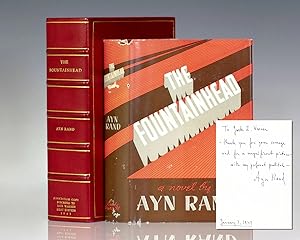
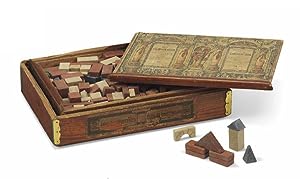
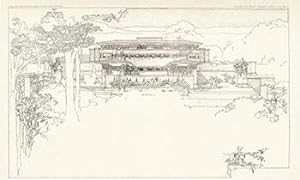

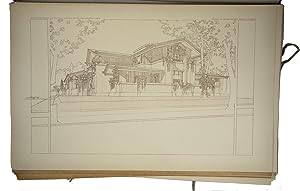
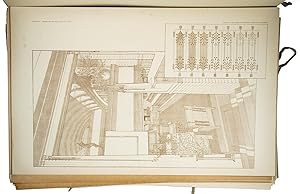
![Imagen del vendedor de Ausgeführte Bauten und Entwürfe von Frank Lloyd Wright (Completed Building and Designs of Frank Lloyd Wright) [The Wasmuth Portfolio] a la venta por Manhattan Rare Book Company, ABAA, ILAB](https://pictures.abebooks.com/inventory/md/md31098742133.jpg)
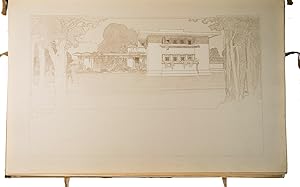
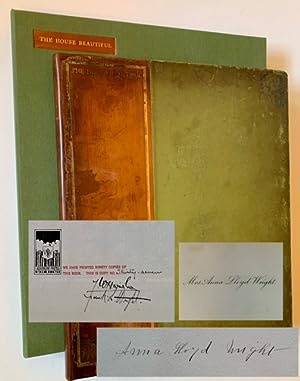


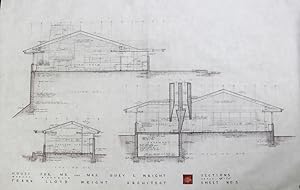
![Imagen del vendedor de [Album containing 154 albumen photographs of Chicago by a noted photographer, including important architectural images, as well as images relating to the preparations for the 1893 World's fair, the stockyards as described by Upton Sinclair, and more] a la venta por Donald A. Heald Rare Books (ABAA)](https://pictures.abebooks.com/inventory/md/md18217490929.jpg)
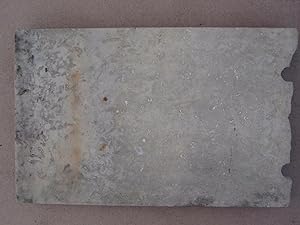


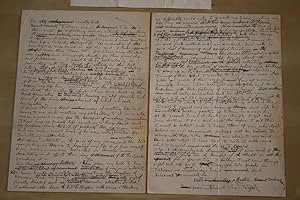
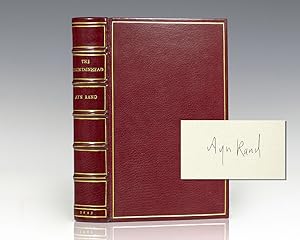
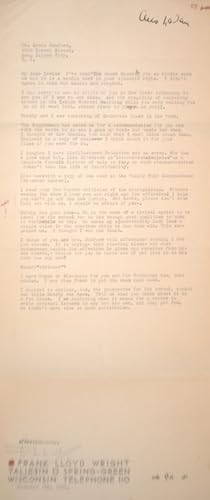
![Imagen del vendedor de Frank Lloyd Wright ALS matted and framed to Lewis Mumford [61 x 37 cm.]; Discusses the Guggenheim Museum a la venta por Royoung Bookseller, Inc. ABAA](https://pictures.abebooks.com/inventory/md/md12653146079.jpg)
